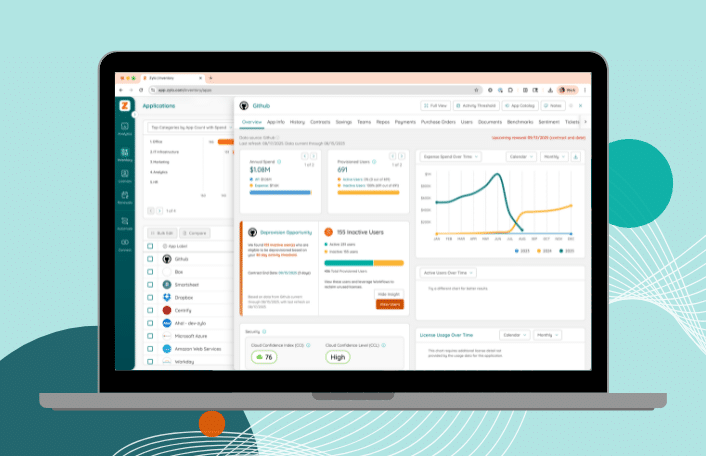
FinOps Software Explained: Benefits, Tools & Key Features
Table of Contents ToggleWhat FinOps Means in the Modern Cloud EnvironmentWhy...
Back
Back
Search for Keywords...
Blog

Table of Contents
GitHub is the backbone of modern software development, powering everything from small open-source projects to global enterprise applications. But while its value is undeniable, managing GitHub licensing is anything but simple. IT practitioners, SAM leaders, and procurement teams face atangle of seat-based subscriptions, add-on features like Copilot and Advanced Security, and unpredictable consumption costs.
 The result? Overspending and unnecessary risk. Zylo data shows that 32.3% of GitHub licenses sit unused, and the average enterprise spends $240,000 annually on GitHub. That’s money that could be reallocated to tools and teams that actually drive value.
The result? Overspending and unnecessary risk. Zylo data shows that 32.3% of GitHub licenses sit unused, and the average enterprise spends $240,000 annually on GitHub. That’s money that could be reallocated to tools and teams that actually drive value.
In this blog, I’ll explain:
GitHub costs break down into three categories:
I do want to call out that GitHub does not offer role-based license levels (like Viewer vs Editor). Instead, every billable user (members of your organization and outside contributors) consumes the same type of seat within a plan. Differentiation comes from the plan chosen (Free, Team, Enterprise) and the add-ons assigned.

Even with the right plan in place, organizations face recurring issues that inflate GitHub costs and increase compliance risk. The most common challenges include:
From my experience, these problems persist because purchasing is often decentralized, reporting is limited, and license management happens reactively at renewal. The result is wasted spend, unnecessary security exposure, and heavy manual effort for IT and SAM teams.
Every member with access to a private repository consumes a paid seat—even if they’ve been inactive for months or are contractors who’ve left. Without lifecycle automation, I’ve seen these “zombie accounts” quietly drain budgets and complicate access governance.
GitHub’s consumption-based features act like cloud services: Actions minutes, VM hours, and storage accumulate quickly. I’ve worked with teams where a single Codespace left running overnight racked up surprising costs. Without clear budgets and idle timeouts, usage becomes unpredictable and expensive.
Manual reviews of GitHub usage are time consuming and prone to error, and IT teams can’t reliably track or revoke access. I’ve seen this leave compliance gaps wide open, creating risk during audits and complicating offboarding.
Without limitations on who can purchase or enable new features or connect outside systems, costs will inflate. In most cases, you won’t know until your monthly bill arrives. At that point, you have to pay and may have a hard time determining who enabled that feature.
IT, SAM, and procurement teams need processes that control costs, support productivity, and ensure compliance. The most effective practices include:
Start with a recurring audit of assigned seats. Many organizations discover inactive users or external collaborators who still consume licenses. Use SCIM provisioning where possible to automatically deactivate accounts when employees leave or projects end.
GitHub Copilot delivers real value when developers actively use it. Instead of assigning licenses across the board, pilot with a smaller group, measure adoption, and expand only where usage justifies the cost.
Treat GitHub’s consumption features the same way you would AWS or Azure.
Each license specifies a maximum number of accounts that can use Advanced Security. Roll it out first on critical repositories where the business impact of vulnerabilities is highest, then evaluate ROI before expanding further.
Manual provisioning and offboarding is error prone. By automating access with SSO and SCIM, IT teams can:
License data should guide procurement. Before renewal, generate usage and adoption reports to identify:
Armed with this data, procurement leaders can right-size contracts, benchmark pricing, and negotiate stronger terms.
GitHub is one of the many apps owned by Microsoft. Purchase it as part of your Microsoft EA to secure better pricing. If you’re already spending a lot on other Microsoft tools, this is a no-brainer.
The strategic value of GitHub license management falls into four key areas:
Reducing unused seats, right-sizing Copilot, and managing consumption features directly lowers spend. Paired with operationalized renewals, we often see companies save 5–10% on applications, freeing budget that can be reinvested into higher-value initiatives. This creates measurable budget impact and equips procurement with stronger leverage during renewals.
Strong license oversight minimizes compliance and security risks. By ensuring access is current and limited to active users, organizations stay prepared for audits and protect sensitive code assets.
According to Zylo’s 2025 SaaS Management Index, IT leaders’ top priorities for 2025 include improving employee productivity, reducing security risks, and cutting operational expenses
Automation of license workflows reduces repetitive manual work. Teams save time that can be redirected to higher-value initiatives like improving developer productivity and scaling security programs.
GitHub is part of a broader SaaS ecosystem. Managing licenses effectively ensures the platform contributes to enterprise goals such as cost avoidance, security, and centralized oversight within a structured SaaS governance framework.
Managing GitHub licenses in spreadsheets or through GitHub’s native admin console leaves blind spots. Zylo’s SaaS Management Platform (SMP) delivers the visibility, automation, and insights that IT, SAM, and procurement teams need to manage GitHub with precision.
Zylo connects directly with GitHub to capture detailed license and repository usage. This provides clarity into who is using GitHub, how often, and whether assigned licenses are delivering value. With centralized visibility across all SaaS, IT and SAM leaders gain a single source of truth.
With Zylo, you can:

Manual audits don’t scale. Zylo automates the monitoring and remediation of unused GitHub licenses through workflows and alerts. This reduces waste and ensures licenses are reassigned where they’re most valuable.
With Zylo, you can:
Benchmarking and optimization insights help ensure you never overpay for GitHub. Zylo Benchmarks show how your license pricing stacks up against peers, while Zylo Insights highlights where usage trends signal optimization opportunities.
With Zylo, you can:

Proactive renewal management prevents costly surprises. Zylo keeps every GitHub renewal on the calendar, with alerts long before contracts auto-renew. This gives procurement teams time to prepare and negotiate on their terms.
With Zylo, you can:

Managing GitHub isn’t just IT’s responsibility—SAM and procurement all play a role. Zylo dashboards bring these teams together on the same data, enabling faster, aligned decision-making.
With Zylo, you can:
ModMed Drives Operational Excellence & Million-Dollar Savings with Zylo SaaS License Management
Discover how ModMed used Zylo’s powerful license tracking and optimization to save millions of dollars, drive operational excellence, and improve the employee experience.
GitHub fuels development, but unmanaged licenses and add-ons drive up costs and create compliance risk. Effective GitHub license management ensures:
Zylo makes this possible. With direct usage integrations, automated alerts, reclamation workflows, and renewal insights, Zylo turns GitHub license management into a proactive, cost-saving practice.
Learn more about our SaaS License Management solution, or schedule time with our team to see it in action.
GitHub uses a seat-based model where every active member or external collaborator with access to a private repository consumes a license. Plans (Free, Team, and Enterprise) set base features, storage, and CI/CD minutes, while add-ons like Copilot and Advanced Security add additional costs. Consumption-based features such as Actions and Codespaces are billed separately.
The most common challenge is unused or underutilized licenses. Dormant accounts, inactive Copilot seats, and unmanaged consumption costs for Actions or Codespaces often create waste. Without automation, IT and SAM teams spend hours manually tracking usage and adjusting assignments.
The most effective tactics include auditing inactive users, scaling Copilot licenses only where adoption is high, setting budgets and idle timeouts for Codespaces, and rolling out Advanced Security selectively. Pairing these practices with renewal insights typically delivers measurable savings.
The best way to optimize GitHub licenses is by combining ongoing audits with automation. IT and SAM teams should track actual usage, reclaim inactive seats through workflows, and adjust add-ons like Copilot and GHAS based on adoption. Pairing usage insights with renewal planning ensures licenses align with business needs and spend is kept under control.
Zylo integrates directly with GitHub to provide real-time usage data. With Workflows, Automated Alerts, Benchmarks, and Dashboards, Zylo helps IT, SAM, and procurement teams reclaim inactive licenses, monitor adoption, and prepare for renewals with confidence.
A SaaS Management Platform like Zylo centralizes license, usage, and spend data across GitHub and all SaaS tools. The result is cost control, reduced compliance risk, and improved cross-functional alignment between IT, SAM, and procurement.
Copilot is licensed per user, with Business ($19 per user/month) and Enterprise ($39 per user/month) plans. Costs increase when licenses are broadly assigned but adoption remains low, making it important to pilot and expand only where usage supports the spend.
Codespaces are billed hourly for compute (starting at $0.18 per 2-core VM) and monthly for storage ($0.07 per GB). Costs can grow quickly if environments are left idle, so setting timeouts and monitoring usage is critical.
ABOUT THE AUTHOR

Connor Mullaney
Connor is a Product Manager at Zylo with a background in customer service, having supported the company’s largest Enterprise clients. In his role today, he helps drive Zylo’s product strategy for SaaS licensing, usage, and consumption/capacity tracking. Before Zylo, Connor worked as a Software Asset Management (SAM) consultant, helping Enterprises build effective licensing positions (ELP) and manage audits for major software publishers. With firsthand experience of how manual SAM and SaaS Management can be, he’s passionate about building solutions that surface meaningful insights and cost-saving opportunities for clients.

Table of Contents ToggleWhat FinOps Means in the Modern Cloud EnvironmentWhy...

Table of Contents ToggleHow GitHub Licensing WorksGitHub Plans and PricingAdd-Ons to...

Table of Contents ToggleHow GitHub Licensing WorksGitHub Plans and PricingAdd-Ons to...

Table of Contents ToggleKey Themes That Shaped SaaS Management in 20251....
| Cookie | Duration | Description |
|---|---|---|
| cookielawinfo-checkbox-analytics | 11 months | This cookie is set by GDPR Cookie Consent plugin. The cookie is used to store the user consent for the cookies in the category "Analytics". |
| cookielawinfo-checkbox-functional | 11 months | The cookie is set by GDPR cookie consent to record the user consent for the cookies in the category "Functional". |
| cookielawinfo-checkbox-necessary | 11 months | This cookie is set by GDPR Cookie Consent plugin. The cookies is used to store the user consent for the cookies in the category "Necessary". |
| cookielawinfo-checkbox-others | 11 months | This cookie is set by GDPR Cookie Consent plugin. The cookie is used to store the user consent for the cookies in the category "Other. |
| cookielawinfo-checkbox-performance | 11 months | This cookie is set by GDPR Cookie Consent plugin. The cookie is used to store the user consent for the cookies in the category "Performance". |
| viewed_cookie_policy | 11 months | The cookie is set by the GDPR Cookie Consent plugin and is used to store whether or not user has consented to the use of cookies. It does not store any personal data. |
